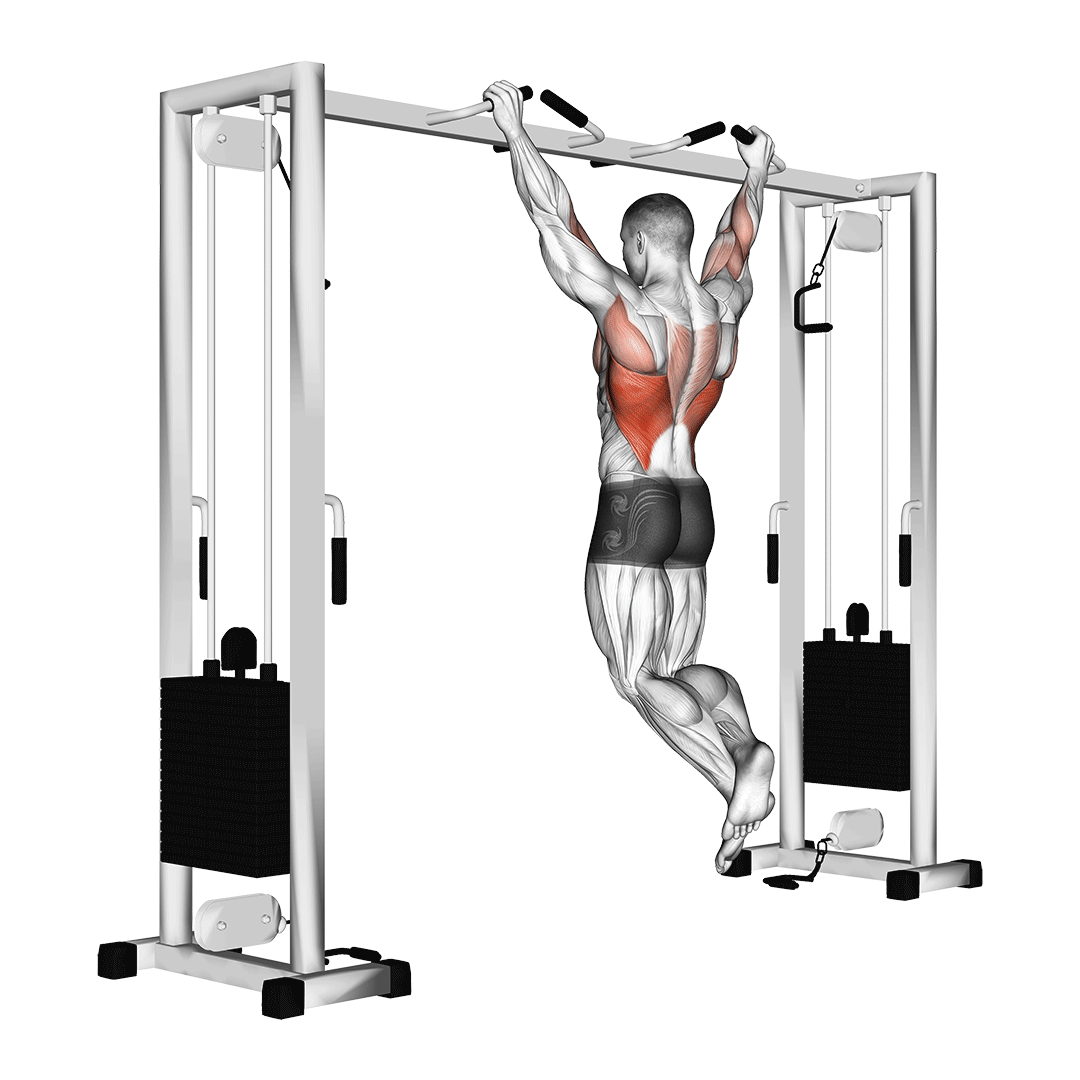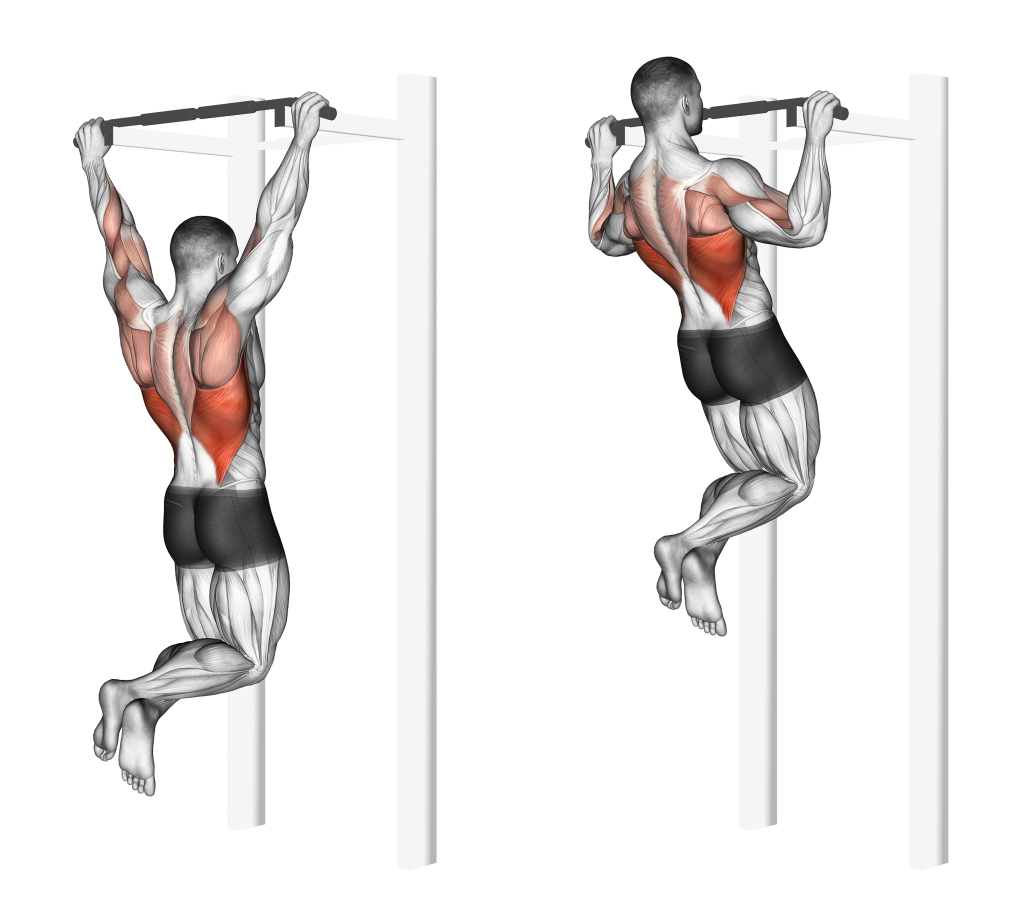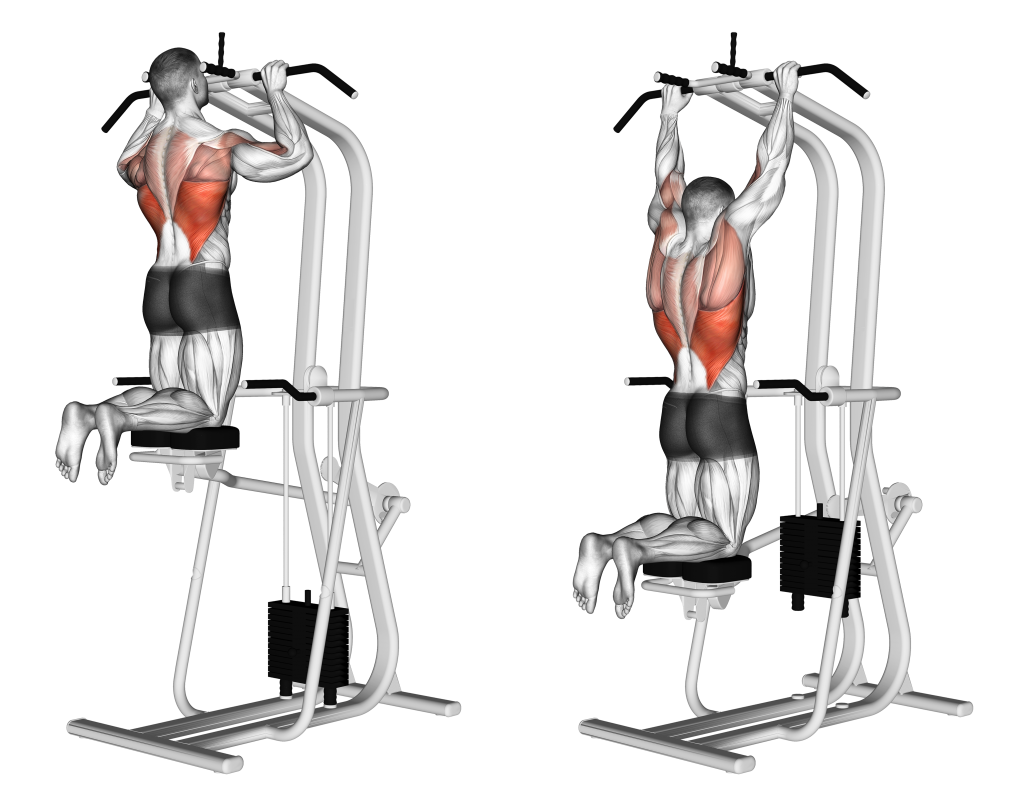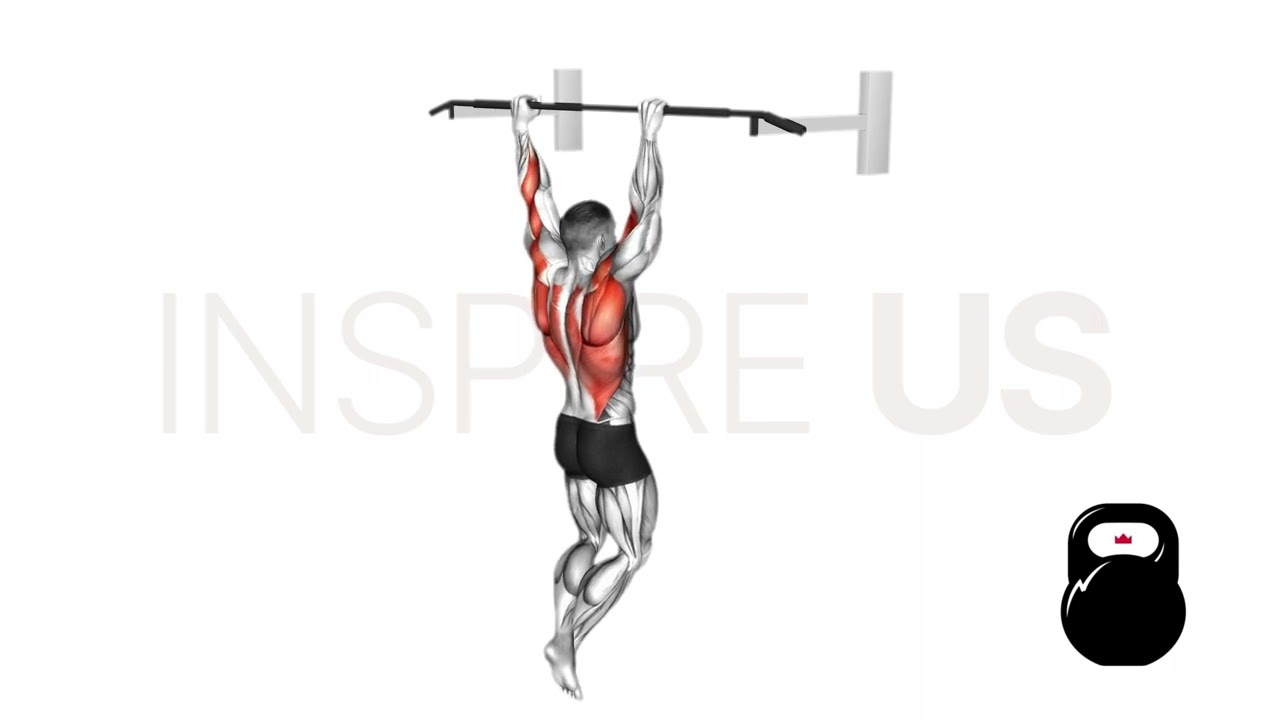Pull Ups: Benefits, Muscles Worked, and More
As iconic as they are irreplaceable; pull-ups are the quintessential calisthenic back exercise, with a low barrier of accessibility but rather high skill ceiling.
While the conventional pull-up needs no introduction, many workout enthusiasts don’t quite understand what makes the pull-up such a staple in bodyweight training - and how they can best take advantage of its many benefits.
To put the pull-up in a nutshell, we can classify it as a bodyweight vertical pulling exercise of intermediate difficulty. It is often included into back workouts as the main compound movement of the session, or otherwise as a secondary compound performed after weighted exercises like the deadlift and barbell row.
What are Pull-Ups?
In a more technical sense, the pull-up is a multi-joint compound movement primarily involving recruitment of muscles like the biceps brachii and latissimus dorsi in a vertical pulling motion.

Pull-ups are well-established among a variety of different training disciplines, and have spawned quite a number of variations and progressions. This is especially true in the realm of calisthenics, where pull-ups have become an essential exercise in every training program.
While its execution is seemingly simplistic, pull-ups involve a number of biomechanics like scapular retraction, shoulder abduction and elbow flexion - each of which are performed as the exerciser suspends themselves from a bar overhead, hence the high skill ceiling involved.
Who Should do Pull-Ups?
Pull-ups are suitable for intermediate exercisers who have already mastered basic exercise mechanics and possess sufficient upper body strength to pull themselves upwards for several repetitions.
How are Pull-Ups Programmed?
Because the conventional pull-up features a fixed level of resistance (the exerciser's own bodyweight), programming the pull-up involves creative usage of volume and tempo.
While novice and intermediate level exercisers will be perfectly fine with conventional volume-based progressive overload, more advanced bodyweight athletes may wish to make use of programming strategies like AMRAP (As Many Reps As Possible) sets, drop sets or even progression exercises to maintain the flow of their progression.
How to do Pull-Ups
To perform a repetition of pull-ups, the exerciser will suspend themselves by their hands from an overhead pull-up bar.
The hands should be in an overhand grip and spaced slightly wider than shoulder width apart.
Contracting the core so as to avoid any swinging of the lower body, the exerciser will then bend at the elbows and draw their torso towards the bar, flexing their latissimus dorsi muscles as they do so.
Once the bar is below the chin, the exerciser will reverse the motion in a slow and controlled manner, taking care not to rapidly descend.
When the exerciser has returned to the original dead hang stance, the repetition is complete.
What Muscles do Pull-Ups Work?
Pull-ups are known as a “compound” exercise, meaning that they use multiple joints and multiple muscle groups to move said joints. However, not all of these muscle groups are worked to the same extent.

The muscles recruited in a dynamic and intense manner are called the primary mover muscles, whereas muscles worked to a lesser capacity are referred to as secondary mover muscles, and those recruited isometrically are referred to as stabilizer muscles.
Primary Mover Muscles
With each repetition of the pull-up, the muscles of the latissimus dorsi, biceps brachii, trapezius, rhomboids, infraspinatus and the posterior head of the deltoid are worked to a highly intense extent.
Because of their role in the pull-up, these aforementioned muscle groups are also the ones that benefit the most.
Secondary Mover and Stabilizer Muscles
In terms of secondary mover muscles, the pull-up primarily utilizes muscles like the brachialis and brachioradialis to support the primary movers.
Furthermore, the core musculature, forearms and erector spinae are all used as stabilizing muscles as well.
What are the Benefits of Doing Pull-Ups?
Even discounting the many benefits of resistance exercises as a whole, pull-ups are still a must-have in any serious training program, as they offer several further advantages that even novice lifters will find useful.
Development of the Back, Arm and Shoulder Muscles
Pull-ups are the quintessential back-and-biceps exercise in calisthenic workouts for a reason.
Unmatched by most other bodyweight exercises, pull-ups are capable of packing on strength and mass in muscle groups like the deltoids, biceps and the entirety of the back’s musculature - all of which are vitally important for exercisers of all types.
In order to take full advantage of the pull-up’s ability to develop muscle in these areas, the exerciser’s recovery methodology and diet should be perfected as well.
Improved Grip Strength and Trunk Stability
As stabilizer muscles, the forearm and core are isometrically contracted throughout the entire length of a pull-up set.
Such training stimulus causes improved stability and endurance in said muscle groups - a form of muscular development that plays an important role in nearly all physical activity, regardless of whether athletic or everyday actions.
While pull-ups are no real substitute to direct muscular stability training, they can play an important role in developing the strength of the core and the endurance of the forearm muscles, especially when combined with abdominal isolation exercise and grip strength training.
Significant Carryover to Certain Sports and Other Vertical Pulling Exercises
Because of its capacity to carry over athletic skills and physical development - pull-ups are widely practiced in many athletic disciplines, even for sports that do not directly involve vertical pulling movements.
This benefit is a result of the muscular growth that is a result of performing pull-ups regularly, the proprioception and bodily control practiced with each repetition and the metabolic adaptations that come with all forms of resistance exercise.
In particular, rock climbers and gymnasts will see the most benefit from pull-ups, as it is mechanically similar to the actions they take when participating in their chosen sport.
Reinforcement of Scapula, Elbow and Shoulder Biomechanics
Pull-ups create tension across nearly all joints in the upper body, causing them to become subsequently reinforced with regular performance. Unlike skeletal musculature, this takes a significant length of time, and lies less in functionality and more in the physical durability of said joints.
Over time, regular practitioners of the pull-up will find that biomechanics involving the elbows, scapula or shoulder joint will become more stable and considerably less prone to injury.
Common Mistakes Made When Doing Pull-Ups
The pull-up is relatively easy in theory, but complex in actual practice. Even advanced calisthenic athletes occasionally break from proper form adherence.
The following form issues are among the most commonly made mistakes during pull-up performance - all of which should be corrected so as to avoid discomfort and injury.
“Cheating” or Kipping Pull-Ups
The most important (and most common) issue with pull-ups is when a lifter performs the exercise with excessive momentum.
This can take the form of the lifter suddenly dropping themselves downwards during the latter half of the repetition, or may also be characterized by the lower body generating additional momentum during the initial phase of the exercise.
In either case, excessive momentum and a marked reduction in time under tension takes place - potentially damaging the joints of the upper body and negating much of the training stimulus that would be otherwise produced by performing the pull-up.
Each repetition of the pull-up should be performed in a slow and controlled manner, with care taken to ensure that no additional force is present apart from what is produced by the right musculature.
Failing to Complete a Full Range of Motion
Another common mistake made during pull-up performance is having an insufficient range of motion.
This will often appear as the lifter failing to return to the dead hang state at the end of each repetition, or otherwise failing to raise themselves high enough over the pull-up bar to maximize muscular contraction.
Both are characteristic of the lifter pushing themselves too far (i.e. their muscles are too fatigued to complete a full repetition), although an insufficient range of motion may simply be due to poor form adherence as well.
Regardless of the cause, ensuring that each repetition of the pull-up is performed with a complete range of motion is essential for maximizing its effectiveness as a training tool.
Incorrect Hand Width
The majority of pull-up shoulder impingement cases are caused by the exerciser setting their hands at an incorrect width - either too far apart and thereby forcing the joint to dislocate, or too close together and causing excessive internal rotation.
Unless specifically performing a different variation of the pull-up, it is important to place the hands only slightly wider than shoulder-width apart. This is the most advantageous position when performing an overhand vertical pulling movement like the pull-up, and is largely accessible to individuals with only an average level of shoulder mobility.
Flaring the Elbows
More of an improperly utilized form cue, rather than a large-scale mistake; flaring the elbows out to the sides during the pull-up can greatly reduce the amount of leverage the exerciser has over their own weight, and can potentially injure the joints of the arms and shoulders.
As much as possible, performers of the pull-up will want to draw their elbows downwards and backwards, rather than laterally outwards.
This will ensure that the back muscles are able to translate as much force as possible through the arms, and that no upper body joints are placed in a disadvantageous position.
Pull-Up Variations and Alternatives
In the event that you find pull-ups do not meet your training needs, there are a number of possible substitute exercises that retain much of the same benefits - but with a few alterations to help fulfill your goals.
1. Chin-Ups
For exercisers wishing to shift the emphasis more towards their biceps, performing chin-ups in lieu of pull-ups is the best option.

Chin-ups are nearly identical to pull-ups, with the sole difference being that chin-ups feature an underhand or supinated grip, rather than a pronated one. This causes the biceps to be directly targeted throughout each repetition, and will generally create an easier exercise as a whole.
2. Assisted Pull-Ups
In the event that the exerciser has not built sufficient upper body strength to perform a full pull-up, many exercisers prefer to use an assisted pull-up machine as a progression step.

The assisted pull-up is performed with a resistance machine aiding the exerciser as they perform an otherwise conventional pull-up, reducing how much of their own weight they are lifting and thereby making the exercise easier to perform.
3. Weighted Pull-Ups
For more advanced body weight lifters, linear progression may be maintained through the addition of further weight - or what is known as simply “weighted pull-ups”.

Weighted pull-ups involve the addition of further resistance through a belt and set of weight plates, but are otherwise identical to conventional pull-ups both mechanically and in terms of training programming.
Frequently Asked Questions (FAQ)
What are Pull-Ups Good For?
Pull-ups are highly versatile and excellent for a variety of training goals - however, they are particularly effective at building up mass and strength in the back, shoulders and arms.
With proper recovery methodology and a solid training program, pull-ups will help lifters build a muscular and strong upper body.
How Many Pull-Ups a Day is Good?
Performing pull-ups on a daily basis can easily overwhelm the body’s capacity to recover from exercise and, in time, result in overtraining and injuries.
Instead, it is best to perform 2-4 sets of moderate intensity, with one final AMRAP (as many repetitions as possible) set at the end. These sets should be performed with at least 24 hours in between each session, with one 48 hour break in each training week.
What Happens if I Do Pull-Ups Everyday?
In truth, performing any exercise on a daily basis is counterintuitive to getting results. Resistance exercise produces micro-tears in the fibers of skeletal musculature - tears that require time away from training in order to heal.
If you were to do pull-ups every day for an extended period of time, it is likely that you will experience irritation, poor muscular growth, fatigue and a number of other unpleasant symptoms.
Rest days should be taken between consecutive workouts.
In Conclusion
Now that you have a firm grasp of what makes the pull-up special, it’s time to put your learning into practice.
Remember to avoid total fatigue when programming your pull-up sets - and that proper form should be prioritized over all other aspects of training.
References:
1. Ronai, Peter M. and Eric P. Scibek. “The Pull-Up.” Strength and Conditioning Journal 36 (2014): 88-90.
2. Antinori, F., Francesco Felici, Francesco Figura, Marco Marchetti and Benjamin Ricci. “Joint moments and work in pull-ups.” The Journal of sports medicine and physical fitness 28 2 (1988): 132-7 .

